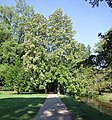Lichtentaler Allee


The Lichtentaler Allee is a historic park and arboretum, set out as a 2.3 kilometer strolling avenue along the west bank of the river Oos in Baden-Baden, Baden-Württemberg, Germany. It is open daily without charge.
- Woody plants
-
 Azaleas
Azaleas -
 Chestnuts
Chestnuts -
 Sequoia giganteum
Sequoia giganteum -
 Magnolia
Magnolia -
 Rhododendron
Rhododendron -
 Maple and beech
Maple and beech -
 Oak
Oak -
 Nyssa sylvatica
Nyssa sylvatica -
 Sycamore
Sycamore
The avenue is said to have begun in 1655 as path between the town market and Lichtenthal monastery. It was developed from 1850 to 1870 at the instigation of the casino Bénazet, and planted with a wide variety of trees and woody plants. Today the avenue contains about 300 types of native and exotic woody plants, including alders, azaleas, chestnuts, ginkgos, limes, magnolias, maples, oaks, and sycamores. The avenue terminates at its northwest end in a kurgarten, and at the southeast in a dahlia garden containing busts of Clara Schumann, Johannes Brahms, and Robert Stolz.
- Dahlia garden
-
 Pavillon Bénazet
Pavillon Bénazet -
 Clara Schumann
Clara Schumann -
 Johannes Brahms
Johannes Brahms -
 Robert Stolz
Robert Stolz -
 Dahlia
Dahlia -
 Dahlia
Dahlia -
 Dahlia garden
Dahlia garden
See also
References
- City Wiki entry (en)
- GardenVisit entry (en)
- bad-bad.de entry (de)
48°45′35″N 8°14′19″E / 48.7597°N 8.23871°E / 48.7597; 8.23871
- v
- t
- e
 | This article related to a park or garden in Germany is a stub. You can help Wikipedia by expanding it. |
- v
- t
- e

























